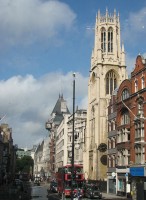
Fleet street starts from Temple Bar by the Law Courts, Britain’s last great Victorian Gothic public building, and in its latter part leading at a slope down to Ludgate Circus offers splendid views of St Paul's Cathedral. Along the way are various Victorian buildings and later ones – some linked with the newspaper industry which used to dominate the street – in a pleasant mix of styles, generally low enough to keep an intimate, human scale to the architecture and a few of which have architectural sculpture. There are also two important churches – St Dunstan in the West and St Bride’s.
Temple Bar marks the boundary between the City of Westminster and the City of London, and the end of the Strand and the beginning of Fleet Street. The old Temple Bar, a great gate built by Wren somewhat in the manner of the old City Gates of London, with statues by Bushnell, was removed to Waltham Cross in 1878 to allow traffic to pass, and then returned to London in modern times to stand on the north side of St Paul’s Cathedral.
Anyway, our modern Temple Bar monument, put up in 1880, of much more modest scale and no hindrance to traffic, stands in the centre of the road, and includes sculpture by four Victorian artists. On the top is the dragon itself – it is a dragon, though often referred to as ‘the griffin’ – which is of course the symbol of the City of London, and hence appropriately marks the boundary on this main thoroughfare from Westminster. Excellently spiky, it stands on its hind legs, forepaws on a shield with the cross of St George – again claimed by the City for its coat of arms – and with wings half spread for balance. Its mouth is agape, the tongue extended, the expression fierce. An excellent beast, by the sculptor C. B. Birch.
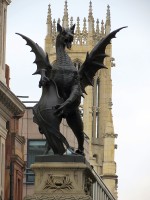 C. B. Birch's City of London Dragon, tower of St Dunstan's behind.
C. B. Birch's City of London Dragon, tower of St Dunstan's behind.
The dragon is raised up on a tall plinth, richly adorned and with recesses on the two sides holding full statues in stone of Queen Victoria and Edward, Prince of Wales, by the sculptor J. E. Boehm. The face of the Queen is rather decayed, doubtless the impact of acid pollution from so much traffic for so many years and does not reflect the skill of the sculptor, but the robes retain a richness often favoured by him, particularly in the recessed areas. The statue of Edward Prince of Wales, later Edward VII, which faces the Courts of Justice, has survived rather better, though a hand has been replaced. This replaced hand rests on his replaced sword (both absent from the picture below), while the other holds up the hem of his long robe.
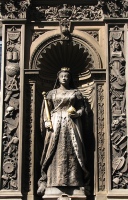
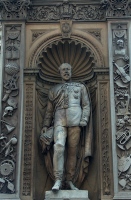 Queen Victoria, and Prince Albert Edward, by J. E. Boehm.
Queen Victoria, and Prince Albert Edward, by J. E. Boehm.
Facing forward and backward, that is to say towards the traffic passing along the street, the plinth is thinner, and is without niches, but rather two tall, thin vertical panels, each with a central attached bust in stone. Facing the Strand side the bust is of a young man in a cap, which according to those wonderful people at the Conway and the book by Ward-Jackson is Prince Albert Victor of Wales, with the Royal crown above, and St George and the dragon beneath. To the Fleet Street side is a portrait of an old man with a beard who was the Lord Mayor of the time, Sir Francis Wyatt Truscott, coat of arms above and medal hanging form his ornate chain of office below.
Now the corners of this plinth, forming the side pilasters of the two niches and the forward and back panels, contain most interesting sculpture in high relief - see edges of pictures above. On the sides with the Royal figures, these columns of sculpture are representative of Science and Art. Science contains a range of instruments, a globe, skull, compasses, staff of Aesculapius, cogwheel and so forth. Art starts at the top with a bust of Chaucer (for the Queen) and of Homer (for the Prince), a pillar for sculpture, a range of musical instruments, modern and ancient, masks of Tragedy and Comedy (see this page for more allegorical representations of Tragedy), a painter’s palette and at the base, tools of the sculptor. On the forward and backward sides, these borders are War and Peace. War has a cavalryman’s helmet, drum, crossed sabres, a head of Medusa, a cuirass, crossed rifles and flags and so forth (for other representations of War see this page); Peace has a dove, a fruiting grapevine, a bowl of fruit held up by dancing cherubs standing on a decorative pillar capital, the tools of agriculture and a sheaf of corn. Assured, crisp work, but who did it?
Panels by C.H. Mabey and C.S. Kelsey; that to the left shows the old Temple Bar.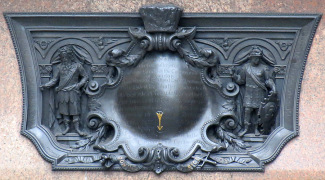
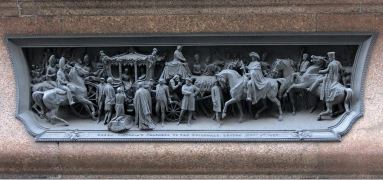
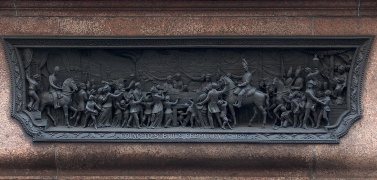
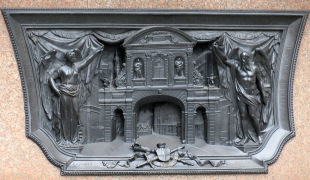
Underneath the main shaft of the plinth is the base, and at the upper part of this are horizontal bronze panels on each side. Three of these are signed by the sculptor C. H. Mabey. We start with the one facing backwards, from the Dragon’s point of view, that is, towards the City – it is a charming and accurate rendition of the Wren Temple Bar mentioned above, with flanking Angel of Fortune and figure of Time. The worn inscription round the edge also notes that Horace Jones was the architect.
The panel facing Westminster includes a cartouche with an inscription flanked by an ancient king and a warrior. The long side underneath the Queen shows her in a carriage in procession to the Guildhall in the City on her accession to the throne in 1837. More than thirty tiny figures and several horses are included in the scene.
The final panel on the other long side of the monument is Queen Victoria and Prince Albert Edward going to St Paul’s, 1872, which has even more figures, a most lively work by C. S. Kelsey, rather reminiscent of the pictures by William Powell Frith.
Taking the assemblage as a whole, we may note that J. E. Boehm was considered one of the best portrait sculptors, and C. B. Birch was also much esteemed, at least for some periods in his rather up-and-down career. By contrast, C. H. Mabey was rather of the second rank in terms of his recognition – panels for the Gibson Hall in Bishopsgate were his most significant commission for a public building; and C. S. Kelsey is really rather obscure, his one familiar work being the admittedly grand sculpture for Smithfield Market.
Let us look at some of the architectural sculpture now.
Almost immediately on the right hand side is the entrance to Middle Temple Hall, with a small sculpture of a sheep holding a flag in high relief dated 1684 (it is shown on the Sheep sculpture page). Next door to this is No. 10, the L&G building, a handsome edifice in pale pink and dark red terra cotta, dated 1885. Along with a variety of minor fructifying decoration are two keystone heads of bearded warriors, and a couple of storeys up, three girlish heads in roundels, with nice flowing hair (above). A couple of doors along is the entrance to Inner Temple, No. 17 – dated 1748 with two little Pegasi in high relief – with above it the Tudor survival known as Prince Henry’s room, a survival from the early 17th Century and thus before the Fire of London. Although not part of this walk, we must note that through these gates gives entrance to the Temple complex of atmospheric quadrangles and buildings, many from the 17th and 18th centuries, and most notably the much earlier Temple Church, home of the Knights Templar in England, which has important early English sculpture. We may also note that up until 1812, in one of the adjacent buildings in this row was housed Mrs Salmon’s Waxworks exhibition.
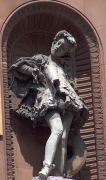
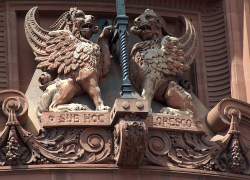 No.193, with Guiseppe Grandi's Kaled statue, and winged lions.
No.193, with Guiseppe Grandi's Kaled statue, and winged lions.
On the other side of the road, a few steps back, Chancery Lane goes off to the left, and the dark red terra cotta building on the corner, No.193 Fleet Street, has sculptural embellishments fairly typical of its 1870s date. The architects were Archer and Green, and the building originally housed a firm of jewellers, and satisfyingly, today houses a goldsmith’s. In a niche facing Fleet Street is a white stone or artificial stone free-standing statue entitled ‘Kaled’, which interestingly is a minor work of a 19th Century Italian sculptor and painter, Giuseppe Grandi (1843–1894). Although there is no sense from this little piece of his grand productions in Milan, the curvy pose with tilted head seems characteristic of several of his statues. According to Ward-Jackson’s book, the statue of Kaled (or 'Khaled'), a subject from a Byron poem called Lara, was owned by the proprietor of the shop rather than having anything particularly to do with his business. Most notable of the terra cotta sculpture on the building is the pair of winged lions at the corner position, with the motto ‘Sub hoc Floresco’ underneath, loosely translating as ‘Under this [sign], flourish’, appropriate for a purveyor of luxury. Rather magnificent beasts, they have manes of fur on their chests mingling with the feathers of the wings, heavy, realistic bodies, but highly stylized wings, and curled tails and tongues (a few more winged lions can be seen towards the end of this page). In cheerful free style often found in such terra cotta decorated buildings, they sit half way down an open curved pediment (not shown in the picture above), the remainder of the pedimental space being occupied by hanging mixes of festooned flowers, grapes, and acanthus, with extra ribbons and beads.
Other decoration on the building includes two small pairs of spandrel girls, and half a dozen relief portraits of artists, including Wedgwood, Michael Angelo and Raphael.
Back on the south side of Fleet Street, there follows a series of interesting 19th Century buildings in a variety of styles, most picturesque – one of the latest is Arthur Blomfield’s Barclays Bank, No. 19. A few doors along, No. 29, of 1860, is particularly embellished, with two bracket figures (see the Caryatids page for more things like this) and much use of inlaid granite and minor decorative features.
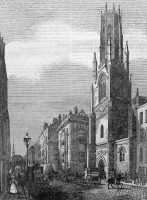
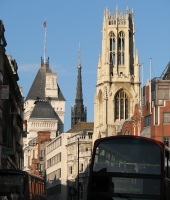 Views of St Dunstan's, older and recent.
Views of St Dunstan's, older and recent.
A few paces past this little group of buildings, on the left hand side is the important church of St Dunstan in the West, with an important interior and some monumental sculpture. However, here we consider just the exterior. If you click on the older view above left, to enlarge it, the old Temple Bar monument may be discerned in the distance; the modern view has the towers of the Royal Courts of Justice in the midground.
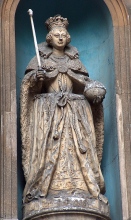 Queen Elizabeth I, probably by William Kerwin, 1586.
Queen Elizabeth I, probably by William Kerwin, 1586.
The previous church on the site suffered in 1829 the same fate as the Temple Bar was to do half a century later, being pulled down to widen the street – unfortunately unlike the monument, the church fabric was not preserved. However, inside the church today, some pre-Fire monuments have been kept from that previous building, and outside, an even more unusual survival. When Ludgate, one of the gates of the medieval walled City of London, was demolished in 1760, the statue upon it of Queen Elizabeth was preserved on a shop against the east end of the church. This, together with a projecting clock overhanging Fleet Street with two wooden statues bearing clubs to strike the time on bells every quarter hour, was taken to the Marquis of Hertford’s residence in Regent’s Park when the church was pulled down, and later returned to the current church on the site. The new church was put up from 1829-33, the architect being John Shaw, and, when he died before the edifice was complete, being finished by his son of the same name. The upper reaches of the tower are a glorious Gothic feature of this end of the street, and looking back from a little distance gives a splendid skyline together with G. E. Street’s Royal Courts of Justice.
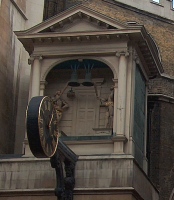
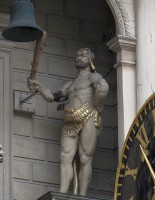 St Dunstan's Clock, and one of the figures.
St Dunstan's Clock, and one of the figures.
Lower down, the main exterior features are indeed the clock and the two chimers, and the statue of Elizabeth I. The clock and strikers were made by Thomas Harrys in 1671, and may have been inspired by the 15th Century conduit in the street which also bore bells, in that case with angels to chime the hours. The two figures on the church are large, wild men dressed in the briefest of garments to show the over-developed muscles of legs and arms, and much painted – looking more like seaside sculpture than anything else. The not-to-be-compared and eminently refined Queen Elizabeth I statue is ascribed to the sculptor William Kerwin, probably made in 1586, and is a well preserved stone figure, with a nicely symmetrical face, and wearing crown, wide ruff, and flamboyant dress, much worked to show the patterns and fabrics.
Equally interesting, in the tiny courtyard of the church, on the right hand side leading to a closed door, a recess in the wall holds the battered stone statues of King Lud, a pre-Roman King who is associated by some with the name London itself, and his two sons, remarkably surviving from Ludgate. These statues, put up on the gate when it was rebuilt in 1586, survived its demolition in 1760, and again via the Marquis of Hertford, are now at St Dunstan’s.
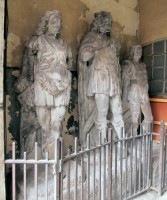
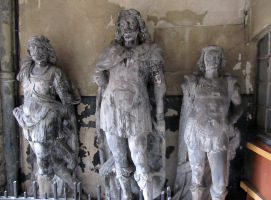
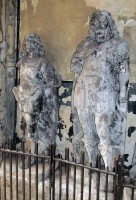 Aspects of the statues of King Lud and his sons.
Aspects of the statues of King Lud and his sons.
These statues are damaged, can only be viewed close up and in less than advantageous lighting, and the many fragments of paint and corrosion give a mottled effect which makes it difficult to properly appreciate them. Lud stands taller than his sons, and is the most complete of the statues, the other two having lost most of their arms while even he has lost a hand and suffered much scratching. However, if we look carefully, we see work of some considerable skill. The head of Lud, framed by long, curled hair, retains something of nobility and presence. He has a wide collar and cloak thrown back over one shoulder and arm, and wears a tight-fitting shirt, or perhaps light armour, softly emphasising the musculature of lower chest and stomach, a short tunic, and calf-high boots turned over at the tops and secured with straps. His pose, body slightly contrapuncto and with one leg a little forward and the opposing arm behind the back, is subtle and dynamic. The son on the left as we look at the group also has long hair, an armoured shirt with perhaps straps of leather to protect the shoulder and surviving upper arm, and appears to be in a walking pose. The second son, the most damaged, has differently styled hair, again an emphasis on the musculature of the torso and legs, and likewise a degree of movement, as if about to move forward. Altogether and even putting aside their important place as surviving elements of a London gate, they are most interesting and unusual, compared to our most familiar work from this period (as far as I am familiar with at least!) being stiffly posed monarchs such as the Queen Elizabeth noted above, and the typically kneeling funereal figures of Tudor times which again have a typical stiffness of pose and conventionality of treatment.
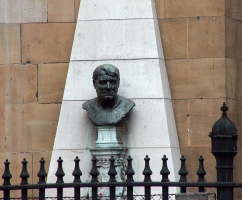 Lady Hilton Young [Lady Scott]'s bust of Northcliffe; monument by Lutyens.
Lady Hilton Young [Lady Scott]'s bust of Northcliffe; monument by Lutyens.
Finally in the little yard we may note the bronze bust of Viscount Northcliffe, the journalist, by Lady Hilton Young (better known as Lady Scott], dating from 1930, the monument as a whole being to the design of Lutyens.
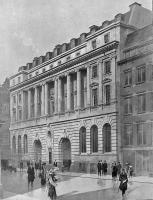
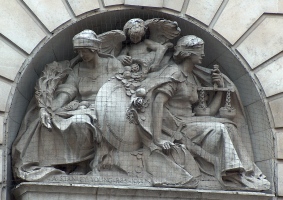 Norwich Union building at No. 50, sculpture by A. Stanley Young.
Norwich Union building at No. 50, sculpture by A. Stanley Young.
We proceed along Fleet Street. On the right, No. 37 is Hoare’s Bank, 1829, with a double headed eagle in high relief above the door. No. 50, impressively large with double height Ionic pillars at first floor level, and two arched entrances to an internal courtyard, was built for the Norwich Union Insurance Society just before the First World War, and has since been taken over by the lawyers of Serjeants Inn, long connected with this part of the Temple area. Howell and Brooks were the architects. In between the two arches is a sculptural group in a recess of Justice and Prudence with Liberality, dated 1913, by the sculptor A. Stanley Young. He is not so familiar from his works – he has a Mercury in Gray’s Inn Road on the top of a building (and a similar one in South Africa on the Union Buildings in Gauteng, Pretoria), and he also made two figures for the Norwich Union head office in Norwich itself, but there is little else by him to see, though he also worked as a medallist. The Fleet Street group makes it regrettable he did not make more; the female figures are fine, their faces art nouveau, their contours rather emphasised by the drapes than concealed, looking forward to the post-war era of less ideal, more hard-edged creations. Prudence is on the left, with her little hoard of fruits and a leafy branch, and fine headgear which could have been drawn by Burne-Jones. Blind Justice, seated on the right, has weighty scales and harmoniously draped sword. Her shield, bearing a small head of Medusa in relief, occupies the central position of the group, and the cherubic figure of Liberality, or Plenty, spills his cornucopia of coins and fruits over it. (More figures of Prudence are noted on this page, and of Justice on this page).
Next door, No. 53, a surprise in Fleet Street, is clad in maroon and green tiles, recollecting a movement towards tile covered buildings for cleanliness and brightness which never really caught on in London, with the notable exception of some of the Underground Stations.
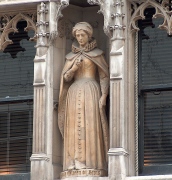 Mary Queen of Scots statue at No.143.
Mary Queen of Scots statue at No.143.
A little way along, on the opposite, north side, No. 143, prettily decorated in a spiky Gothic vein, has a statue of Mary Queen of Scots, a turn of the century figure nicely complementing the much earlier Queen Elizabeth we have seen at St Dunstan’s in the West. She stands, head bowed slightly down, wearing an elegant headpiece, a wide ruff, and cloak over her bodice and long, many-buttoned skirt; the building was erected with the name Mary Queen of Scots House in 1905.
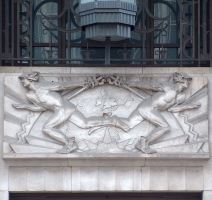
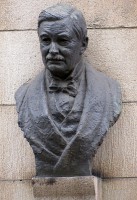
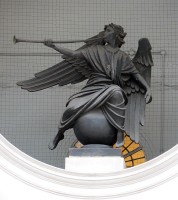 Deco-era journalistic sculpture: Daily Telegraph's Mercury sign, O'Connor monument, and Reuters' Fame.
Deco-era journalistic sculpture: Daily Telegraph's Mercury sign, O'Connor monument, and Reuters' Fame.
The Kings and Keys Tavern next door (the modern signpost has made it just one king), a single bay wide, has leafy decoration from 1884. This part of Fleet Street and the surrounding courtyards and alleys used to be the heart of the newspaper industry. That is not a subject for these pages, but we do have a few sculptural excuses to mention this, starting next door to the tavern: Nos. 135-141 Fleet Street was built for the Daily Telegraph in 1928-31, the architects being Elcock and Sutcliffe, with Thomas Tait. A bold construction with tall Egyptianised pillars and a projecting clock, it has the look of an Odeon cinema. Above the entrance is a sculptured plaque with twin nude figures of Mercury the Herald speeding outwards from the centre, each carrying his caduceus staff. As studies of the male nude, the musculature is highly simplified, not uncommon for art deco statuary, and the position of the hands and thrust of the neck are especially characteristic of the period. A sunburst is behind, combined with the upper part of the globe, with Britain of course in the centre. All this very deco too.
More or less opposite, on the wall of a building is a bronze bust of the journalist T. P. O’Connor, d.1929, by the sculptor F. W. Doyle-Jones, whose best-known works are the two groups flanking the entrance to Waterloo Station, in memory of World War 1. A little further down on the right hand side, just past Salisbury Court, is the Reuters Building, No. 85 Fleet Street, by Lutyens, mid 1930s, with a recessed portico within an arch, in which a large round window is occupied by a bronze statue of Fame. She is a stylized angel, seated on a globe and blowing a long, slender trumpet. Her wings are absolutely 1930s, her drapery mainly pipe-folds, pulled tight at the hem by her splayed legs, and by contrast gently shaped by gravity across the upper body. A work of originality by the sculptor William Reid Dick. Almost opposite is the modernistic black-clad Express Building, 1931 – peer in to see one of the most important deco entrance halls.
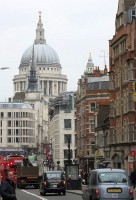
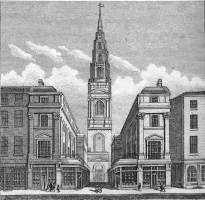
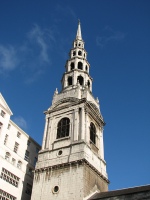 View of St Paul's with St Martin's (left), and St Bride's (middle, right), all three by Christopher Wren.
View of St Paul's with St Martin's (left), and St Bride's (middle, right), all three by Christopher Wren.
By this time, Fleet Street is descending an incline towards Ludgate Circus, and there is an iconic view of St Pauls beyond that (above left), with the narrow spire of St Martin’s Ludgate in front. But we have a nearer church than that to look at. The alley next to the Reuters Building gives us a view of the famous wedding cake spire of St Bride’s Church, set back a few paces from the street, as shown in the view above centre, from the 1840s. The body of the church is from the 1670s, with Christopher Wren’s tallest spire dating from 1701-3 – it is in fact too tall to appreciate from here, as the picture above right indicates, and the best views are from some distance.
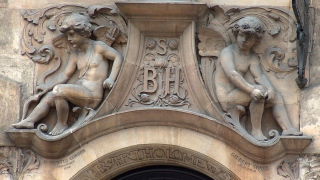 No. 92 Fleet Street, typical work by Gilbert Seale.
No. 92 Fleet Street, typical work by Gilbert Seale.
Close to the church along the street are our final two works of sculptural interest. Above the door of No. 92 Fleet Street, called St Bartholomew House, we may note a pair of cherubs, by the sculptor Gilbert Seale; typical of the work of this minor architectural sculptor. The architect was H. Huntley Gordon, and the date, 1900. And finally, the last building on the right, on the corner with Ludgate Circus, Nos. 107-111 Fleet Street, is a highly decorated building of the early 1870s, which has cherubs over the doors, a long line of portrait heads and garlands above the first floor, and panels with more pairs of frolicking cherubs two floors higher. We can avert our gaze quickly from these latter, but the heads, in keystone positions above each flat topped window, are particularly worth study. And thus ends Fleet Street.
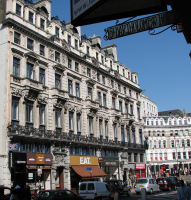
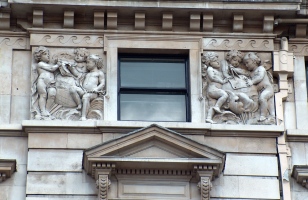
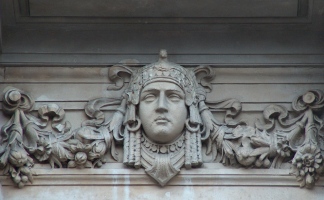
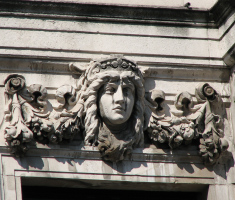 No.107-111 Fleet Street, and details.
No.107-111 Fleet Street, and details.
West to the Strand // or to Aldwych // Southwards to walk along the Embankment // East to St Martin's Ludgate
Visits to this page from 13 Mar 2014: 27,928